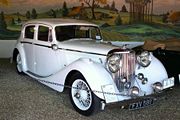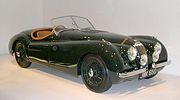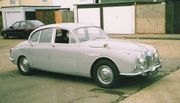Jaguar Cars
2008/9 Schools Wikipedia Selection. Related subjects: Road transport
| Jaguar Cars Ltd | |
|---|---|
 |
|
| Type | Subsidiary of Ford Motor Company |
| Founded | 1922 |
| Founder | Sir William Lyons |
| Headquarters | |
| Key people | Geoff Polites, ceo Mike O'Driscoll, md |
| Industry | Automotive |
| Products | Automobile |
| Employees | 10,000 |
| Parent | Ford Premier Automotive Group |
| Website | Jaguar.com |
Jaguar Cars Limited is a luxury car manufacturer, originally based at Browns Lane, Coventry, England but now at Whitley, Coventry. It was founded as the Swallow Sidecar Company in 1922, changing to SS Cars Ltd in 1934, and finally becoming Jaguar Cars Ltd in 1945.
While Jaguar is currently part of the Premier Automotive Group, Ford is considering divesting both Jaguar and Land Rover, with India's Tata Motors the frontrunner to buy the brands.
The name is pronounced /ˈdʒægjuːɚ/ "jag-u-ar", with the term "Jag" being used colloquially.
History
Founded as the Swallow Sidecar Company in 1922, by two motorcycle enthusiasts, William Lyons and William Walmsley, the SS Jaguar name first appeared on a 2.5 litre saloon in 1935. The Jaguar name was given to the entire company in 1945.
Jaguar made its name in the 1950s with a series of elegantly-styled sports cars and luxury saloons. The company bought the Daimler car company (not to be confused with Daimler-Benz), in 1960 from Birmingham Small Arms Company (BSA). From the late 1960s, Daimler was used as a brand name for Jaguar's most luxurious saloons.
Jaguar merged with the British Motor Corporation (BMC), the Austin- Morris combine, to form British Motor Holdings (BMH) in 1966. After merging with Leyland and Rover, the resultant company then became British Leyland Motor Corporation (BLMC) in 1968. Financial difficulties and the publication of the Ryder Report led to effective nationalisation in 1975 and the company became BL Ltd (BL).
In 1984, Jaguar was floated off as a separate company on the stock market — one of the Thatcher government's many privatisations. The Ford Motor Company made an offer to purchase the company in September 1989 which was accepted at an Extraordinary General Meeting in January 1990 and Jaguar was removed from the London Stock Exchange listings on 28 February 1990. In 1999 it became part of Ford's new Premier Automotive Group along with Aston Martin, Volvo Cars and, from 2000, Land Rover; Aston Martin was subsequently sold off in 2007. Since Ford purchased Jaguar in 1989 it has yet to earn a profit for the Dearborn-based auto manufacturer.
Jaguar cars gained a reputation for unreliability during the 1970s and 1980s, but under Ford the reliability and build quality improved dramatically, with the company coming 7th (out of 30) in the J. D. Power Customer Satisfaction Survey (the '242-million mile road test'), and the S-Type coming 9th out of 105 cars in the same survey. In the 2003 Top Gear Survey, the XJ8 (X308) model came first. Also, in 2007, another survey by J.D. Power & Associates showed Jaguar to be the number one car company in customer satisfaction; scoring the highest ratings ever recorded.
The company was originally located in Blackpool but moved to Coventry in 1928 when demand for the Austin Swallow became too great for the factory's capacity. Today, Jaguars are assembled at Castle Bromwich in Birmingham and Halewood in Liverpool. The historic Browns Lane plant closed in 2005, leaving the XJ, XK and S-Type production at Castle Bromwich and the X-Type at Halewood, alongside the new Land Rover Freelander 2, from 2007.
Since Land Rover's 2002 purchase by Ford, it has been closely associated with Jaguar. In many countries they share a common sales and distribution network (including shared dealerships), and some models now share common components, although the only shared production facility is Halewood, for the X-Type and the Freelander 2.
Jaguar Cars holds Royal Warrants from both HM Queen Elizabeth II and HRH Prince Charles.
Divestiture process
On 11 June 2007, Ford announced that it planned to sell Jaguar, along with Land Rover. Ford is retaining the services of Goldman Sachs, Morgan Stanley and HSBC to advise it on the deal. The sale was initially expected to be announced by September 2007, but was delayed till the beginning of 2008. Private equity forms such as Alchemy Partners of the UK, TPG Capital, Ripplewood Holdings (which hired former Ford Europe executive Sir Nick Scheele to head its bid), Cerberus Capital Management and One Equity Partners (owned by JP Morgan Chase and managed by former Ford executive Jacques Nasser) of the US, besides Tata Motors of India and a consortium comprising Mahindra and Mahindra (an auto manufacturer from India) and Apollo Management had initially expressed interest in purchasing the marques from the Ford Motor Company.
Before the sale was announced, Anthony Bamford, chairman of British excavators manufacturer JCB had expressed interest in purchasing the company in August 2006, only to back out later when told the sale would also involve Land Rover, which he did not intend to buy. Tata Motors have received endorsements from the Transport And General Worker's Union (TGWU)- Amicus combine as well as from Ford. On Christmas Eve of 2007, Mahindra and Mahindra backed out of the race for both brands, citing complexities in the deal.
On January 1, 2008, Ford made a formal announcement which declared Tata as the preferred bidder. According to the rules of the auction process, this announcement would not automatically disqualify any other potential suitor. However, Ford (as well as representatives of Unite) would now be able to enter into more focused and detailed discussions with Tata to iron out issues ranging from labor concerns (job security and pensions), technology (IT systems and engine production) and intellectual property, as well as the final sale price. Ford would also open its books for a more comprehensive due diligence by Tata.
Historical models
The Jaguar company started production with the pre-war 1.5, 2.5 and 3.5 litre models which used engines designed by the Standard Motor Company. The 1.5 litre four-cylinder engine was still supplied by Standard but the two larger six-cylinder ones were made in house. These cars have become known unofficially as Mark IVs.
The first post war model was the 1948 Mark V available with either 2.5 or 3.5 litre engines and had a more streamlined appearance than pre-war models, but more important was the change to independent front suspension and hydraulic brakes.
The big breakthrough was the launch in 1948 of the XK120 sports car, with the new XK twin overhead camshaft (DOHC) 3.5 litre hemi-head six-cylinder engine designed by William Heynes, Walter Hassan and Claude Baily. This engine had been designed during the long nights during the war when they would be on fire watch in the factory. After several attempts a final design was arrived at. That is until owner William Lyons said "make it quieter". The car had originally been intended as a short production model of about 200 vehicles as a test bed for the new engine until its intended home, the new Mark VII saloon, was ready. The XK120's reception was such that production continued until 1954; it was followed by the XK140, the XK150, and the E-Type, keeping Jaguar in the sports car market.
Introducing the large Mark VII saloon in 1951, a car especially conceived for the American market, Jaguar soon found itself overwhelmed with orders. The Mark VII and its successors gathered rave reviews from magazines such as Road & Track and The Motor. In 1956 a Mark VII won the prestigious Monte Carlo Rally.
The 1955 Mark 1 small saloon was the first monocoque (unibody) car from Jaguar and used a 2.4 litre short stroke version of the XK engine. In 1959, the car was improved with a larger engine and wider windows and became the Mark 2, one of the most recognizable Jaguar models ever produced. It would be popular with British police forces for its small size, light weight, and powerful engine.
The Mark VIII of 1956 and Mark IX of 1958 were essentially updates of the Mark VII but the Mark X of 1961 was a completely new design of large saloon with all round independent suspension and unibody construction.
The independent rear suspension from the Mark X was incorporated in the 1963 S-Type which closely resembled the Mark 2, and in 1967 the Mark 2 name was dropped when the small saloon became the 240/340 range. The 420 of 1966, also sold as the Daimler Sovereign, put a new front onto the S-type, although both cars continued in parallel until the S-Type was dropped in 1968. The Mark X became the 420G in 1966.
Of the more recent saloons, the most significant is the XJ (1968-present), still the definitive Jaguar saloon car for many. Since 1968 the Series I XJ has seen major changes in 1973 (to Series II), 1979 (Series III), 1986 Europe / 1987 United States (XJ40), 1995 (X300), 1997 (to the V-8 powered X308), 2003 (the present model, X350). The most luxurious XJ models carry either the Vanden Plas (US) or Daimler (rest of world) nameplates.
Notable models
Sports:
- 1948–1954 XK120
- 1954–1957 XK140
- 1957–1961 XK150
- 1961–1974 E-Type
- 1975–1996 XJ-S
- 1997–2006 XK (X100)
- 2007-date XK (X150)
Compact & Meduim Executive:
- 1935–1949 1½ Litre saloon
- 1955–1959 Mark 1
- 1959–1967 Mark 2
- 1963–1968 S-type
- 1966–1970 420
- 1967–1969 240 & 340
- 1999-2008 S-type
- 2001-date X-type
- 2008-date XF (new model replacing S-Type)
Large Executive:
- 1935–1948 2½ Litre saloon
- 1937–1948 3½ Litre saloon
- 1948–1951 Mark V
- 1951–1957 Mark VII (& VIIM)
- 1957–1959 Mark VIII
- 1959–1961 Mark IX
- 1961-1966 Mark X
- 1966-1970 420G
- 1968–1987 XJ6 Series 1, 2 & 3
- 1972–1992 XJ12
- 1986–1994 XJ6 (XJ40)
- 1993–1994 XJ12 (XJ81)
- 1995–1997 XJ6 & XJ12 (X300 & X301)
- 1997–2002 XJ8 (X308)
- 2003–date XJ (X350)
Engines
Jaguar has designed in-house four generations of engines.
- Historical engines:
- Jaguar XK6 engine – inline-6
- Jaguar V12 engine – V12
- Jaguar AJ6 engine – inline-6
- Current engines:
- Jaguar AJ-V8 engine – V8
- Jaguar AJ-V6 engine – V6
Current models
The current Jaguar line-up includes the following models:
| 2007 Jaguar Model Line-up | |||
| Model | US Type | Price Range | Notes |
|---|---|---|---|
| XJ | Full-size luxury sedan | £43,642 - £60,252 ($64,250 – $116,000) | |
| S-Type | Executive car luxury sedan | £29,097 - £45,102 ($46,500 – $66,500) | To be replaced by the Jaguar XF |
| X-Type | Entry level luxury sedan and wagon | £21,500 -£30,995 ($33,500 – $37,500) | |
| XK | Sports car/ Coupé/Convertible | £60,097 - £76,097 ($75,500 – $93,000) | |
| XF | Sports car/ Saloon | £33,900 - £54,900 ($49,975 - $62,975) | |
Concept models
- Pirana (1967)
- XK180 (1998)
- F-type (2000) – Roadster, similar to the XK8 but smaller
- R-Coupé (2002) – Luxury four-seater coupé, closest competitor being the Bentley Continental GT.
- Fuore XF 10 (2003)
- R-D6 (2003) – Compact four-seat coupé
- XK-RR – A high-performance version of last generation XK coupé
- XK-RS – Another performance-spec version of last generation XK convertible
- Concept Eight (2004) – Super-luxury version of the long-wheelbase model of the XJ
- C-XF (2007)
The XF is out
Jaguar's motorsport history
The company has had major success in sports car racing, particularly in the Le Mans 24 Hours. Victories came in 1951 and 1953 with the C-Type, then in 1955, 1956 and 1957 with the D-Type. The manager of the racing team during this period, Lofty England, later went on to become CEO of Jaguar in the early 1970s. Although the prototype XJ13 was built in the mid-1960s it was never raced, and the famous race was then left for many years, until in the mid-1980s when Tom Walkinshaw's TWR team started designing and preparing Jaguar V12-engined sports prototypes for European sports car races. The team started winning regularly from 1987, and with increased factory backing the team won Le Mans in 1988 and 1990.
In the late 1990s, Ford decided that Jaguar would be the corporation's Formula One entry. Ford bought out the semi-works Stewart Grand Prix team and rebranded it as Jaguar Racing. The Jaguar F1 program was not a success however, achieving only two podium finishes in five seasons of competition between 2000 and 2004. At the end of 2004, with costs mounting and Ford's profits dwindling, the F1 team was sold to Red Bull energy drinks owner Dietrich Mateschitz, and it became Red Bull Racing. Since 2004 Jaguar has not had an official presence in motorsport.
Notable Jaguar sports racers:
- Jaguar C-Type (1951–53)
- Jaguar D-Type (1954–57)
- Jaguar Lightweight E-Type
- Jaguar XJR Sportscars
- Jaguar XJR-9 (1988)
- XJ220 (1988)
- XJR-15 (1990)







